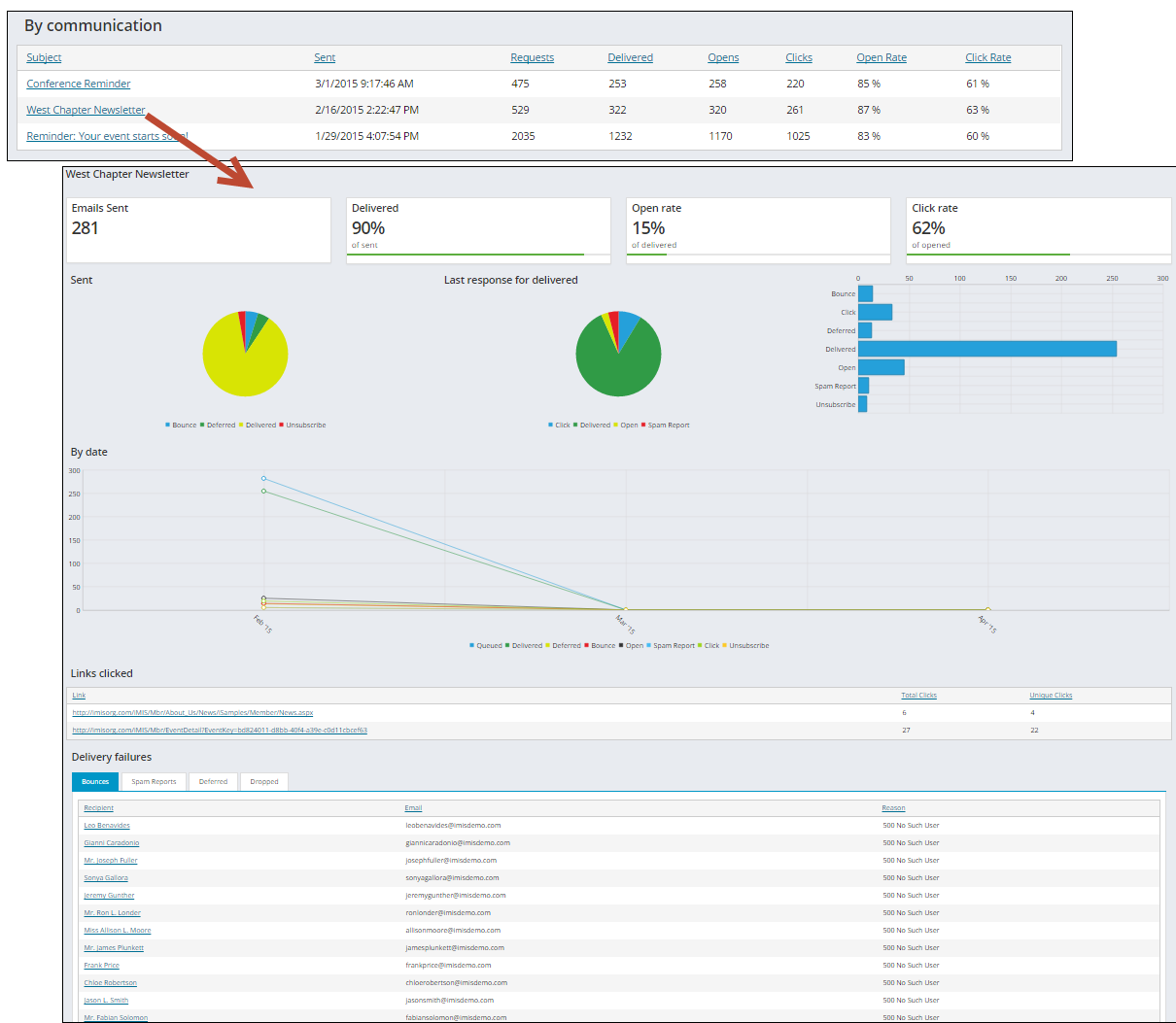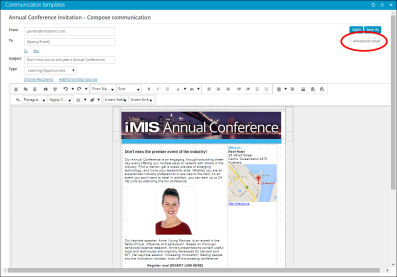Setting up Advanced email PLUS
Note: The following information is considered a PLUS feature and requires additional licensing.
Advanced Email Marketing makes it easy for you to manage interactions with your constituents, providing you with the tools you need to make interactions efficient and effective. This feature enables you to send email more reliably, track the effectiveness of individual emailed communications, and apply what you learn to continually improve your communication approach.
With Advanced Email Marketing, you will know such details as why a message failed to reach the recipient, when a message was delivered, whether a communication was opened, what links were clicked, who marked the communication as spam, and much more. You can analyze communications both at an individual level by reviewing the details of a single message to a particular recipient to see what email events occurred, or at an overall level by analyzing one or more communications to determine its effectiveness, identifying which links were presented in a way that enticed readers to click the links, and so on.
The data collected from the Advanced email interactions are beautifully displayed in several dashboards within the Staff site. The dashboards display statistics for an individual email, or across all emails sent within the last twelve months.
Note: In order to use Advanced email, you must have a license key. Contact your AiSP or ASI for more information.
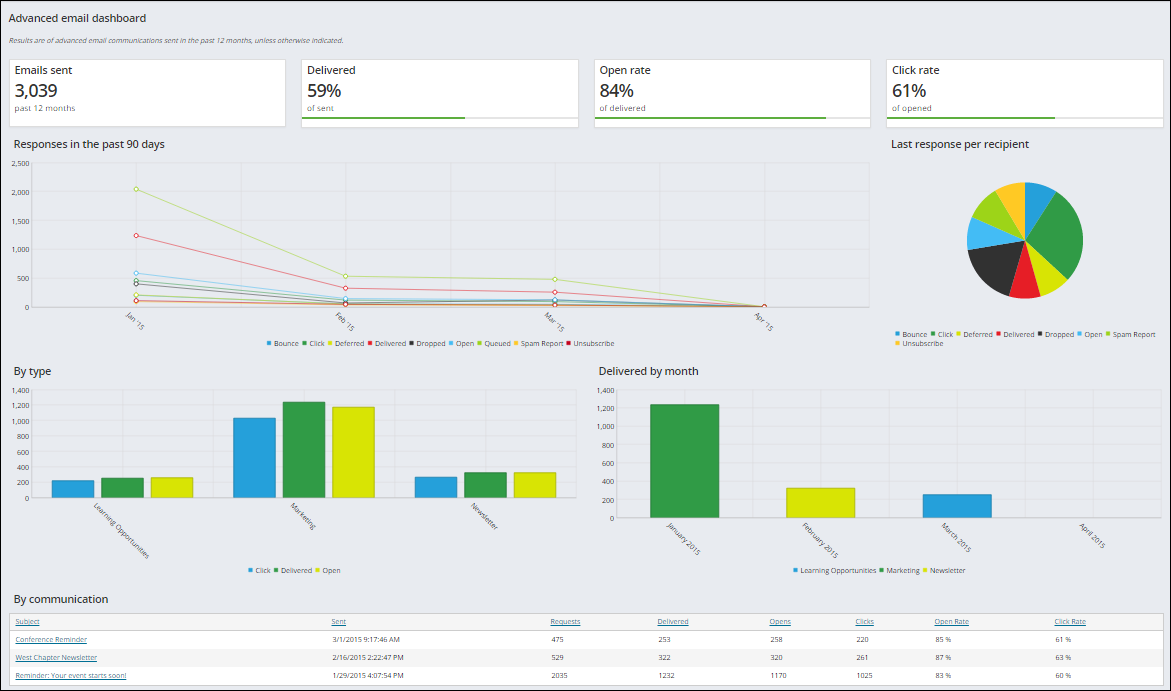
Do the following to configure your Advanced Email:
- From the Staff site, go to Settings > Advanced email.
- Provide the required information. The Disabled notifications option provides Staff users the ability to enable or disable email notifications. When this option is selected, email notifications will not be received.
- (optional) Advanced Email is disabled by default for test databases in order to avoid redirection of live email notifications to the test database. A Reactivate button is displayed whenever a change in the configured SQL server or database name is detected. Click Reactivate only when the database is the primary live database. This database will then receive notifications, whereas any previously configured database will not.
- If Reactivate is accidentally clicked and you want to revert to using the original database, go to Settings for the original instance and click Save. This will update the Advanced Email service account with the original notification URL.
- Enabling and disabling notifications turns notification tracking for all new Advanced Emails for all instances of iMIS for an organization on and off. Deactivate and Reactivate updates the Advanced Email server setting for the URL to which all email notifications will be sent. Deactivation happens automatically whenever iMIS determines that the current database or SQL server name has changed, whereas reactivation for any instance of iMIS sets the email notification URL to point to the instance from which you reactivate, as the live database.
- Click Save.
Note: It is recommended that you contact your IT department to complete the remaining steps.
- By default, ASI chooses "imismail" as your subdomain. If you would like to change this subdomain name, you must contact ASI. You are only able to have one subdomain name.
- ASI will automatically create a whitelabel per the website address that is submitted in the advanced email settings (step 2 above). If you will be using additional domains to send emails from, please contact ASI to have these added to your whitelabels. After the whitelabel is created, ASI will then send you CNAME records so that you can add the records to your DNS.
Note: ASI must whitelabel your domain before emails can be successfully sent. Emails will not successfully send if the From field does not contain an email address that matches the whitelabeled domain name.
Before sending Advanced Email communications, review the following:
- It is recommended that you only perform mass mailings using Advanced Email during off-peak hours.
- The Advanced email checkbox is not displayed in the communication template if an account has not been created, and is disabled if the database has not been reactivated, for example, on a test database. See Advanced Email for more information.
- The email address in the From field must be a valid email with a domain that has previously been whitelabeled. See Configuring Advanced email for more information.
- The foreach placeholder cannot be used in Advanced Email communications.
- When sending an email, the BCC and CC links, as well as the Attachment link, are not displayed. Advanced Email does not support the ability to include repeating data in the email from an associated data source. For more information, see Working with communication templates.
- Advanced email communications cannot be sent with more than 20 custom fields (insert fields). For example, you are creating an email for five people, and have a custom field in the subject line, for their name, two references in the body that detail event schedule items, and then one for your name. In this situation, you have used a total of five custom fields, and have a remaining 15.
Note: This limit is reset about 24-hours after the last communication was sent.
Do the following to send an email using Advanced Email:
- Compose an email. For example, select Marketing > Communication templates > Templates > Samples > Annual Conference Invitation.
- Within the Communication Creator, enable Advanced email before sending. This option must be enabled in order to track and report the results of each Advanced email communication.
- Click Send Now.
- To analyze Advanced email statistics navigate to Marketing > Advanced email.
Note: The Advanced email checkbox will not display if an account has not been created, and will be disabled if the database has not been reactivated, for example, on a test database. See Advanced email settings for more information.
Note: When sending an email, the BCC and CC links as well as the Attachment link will not display. The repeater feature is also not supported with Advanced email.
You can use the Interaction Log content item to track your organization’s email communications with your contacts. Each communication will display the date, time, type, subject, and owner of the communication on the recipient's account page. A recipient's interaction log will report how the communication was processed:
- Queued - The communication has been sent to the Advanced email server.
- Delivered - The communication has been successfully delivered to the recipient.
- Dropped - The communication was not sent to the recipient because the email address is already known to be invalid, has repeated bounces, or multiple spam reports.
- Opened - The communication was viewed by the recipient.
- Clicked - The recipient selected a link within the communication.
- Bounced - The communication was not successfully delivered and has been reported back to the sender along with any errors or text returned from the recipient.
- Unsubscribe - The recipient has opted out of receiving this communication type. See Changing contact communication preferences for more information.
- Deferred - A transient communication problem with the recipient has occurred and is likely to self correct. See Troubleshooting for more information.
- Reported as Spam - The recipient reported the communication as spam. See Tracking email interaction with contacts for more information.
Note: The Advanced email service automatically drops emails in order to protect your sender reputation.
Note: The Details column will display the link that the recipient selected.
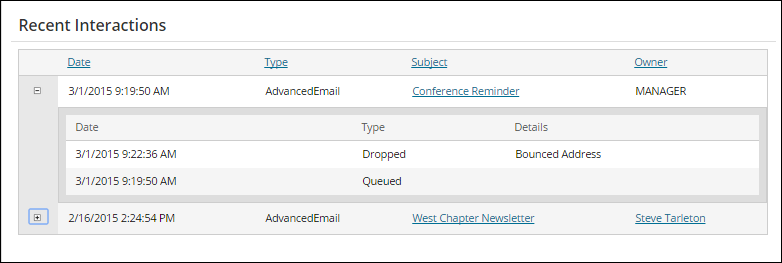
Note: The times assigned to the interaction log events are based on the timezone from the iMIS application server. The time and dates cannot be adjusted.
- If iMIS does not know how to process a reported event, an error message will be written to both the error log at C:\Asi.Scheduler\Asi.Scheduler.log and to the EventViewer.
- If there is a communication problem between the Advanced email server and the iMIS application server, the Advanced email server will mark the notification as deferred, and re-send the event notification for up to 24 hours. The maximum number of deferred items in this retry queue is 100,000 communications. When the communications exceed the maximum number of deferred items, the oldest request in the queue is removed.
- Email notifications that cannot be submitted within the maximum retry period or events removed from the defer queue will be lost.
The Advanced email dashboards are displayed and accessed on the Staff site by navigating to Marketing > Advanced email.
These sample dashboards are configured out-of-the-box using both the InteractionLog and InteractionLogEventSummary business objects to display the Advanced email statistics, and can be tailored to your preference.
The Advanced email dashboard displays the results of every Advanced email communication sent in the past 12 months, unless otherwise indicated.
Note: The following graphs and charts are configured out-of-the-box, but can be tailored to your preference.
- The Emails Sent is calculated by the number of total email requests that were sent as an Advanced email.
- The percentage of Delivered emails reflect the total percent of requested emails that were successfully delivered to the recipient. This calculation does not include dropped, bounced, unsubscribed, or deferred emails.
- The Open Rate reflects the number of recipients who have opened the email at least once (unique opens), divided by the total number of emails delivered. For example, if a recipient opens a communication multiple times, the unique opens will only calculate the first time the recipient opened the communication.
- The Click Rate reflects the number of recipients who have clicked on any links within an email (unique clicks), divided by the number of emails that were opened. For example, if a recipient opens a communication and clicks on a link, the unique clicks will only calculate the first time the recipient clicked on a link within the communication.

- The Responses in the Past 30 Days graph displays an accumulation of each type of Advanced email interaction for each day over a specified month. See the Query Chart Viewer in for more information.
- The Last Response Per Receipt displays an accumulation of the last action the recipient performed after receiving the Advanced email. See the Query Chart Viewer for more information.
- The By Type chart displays the total number of communications for each defined communication type. See Adding a new communication type for more information.
- The Delivered by Month chart displays the total number of communication types sent per month by communication type. See Adding a new communication type or more information.
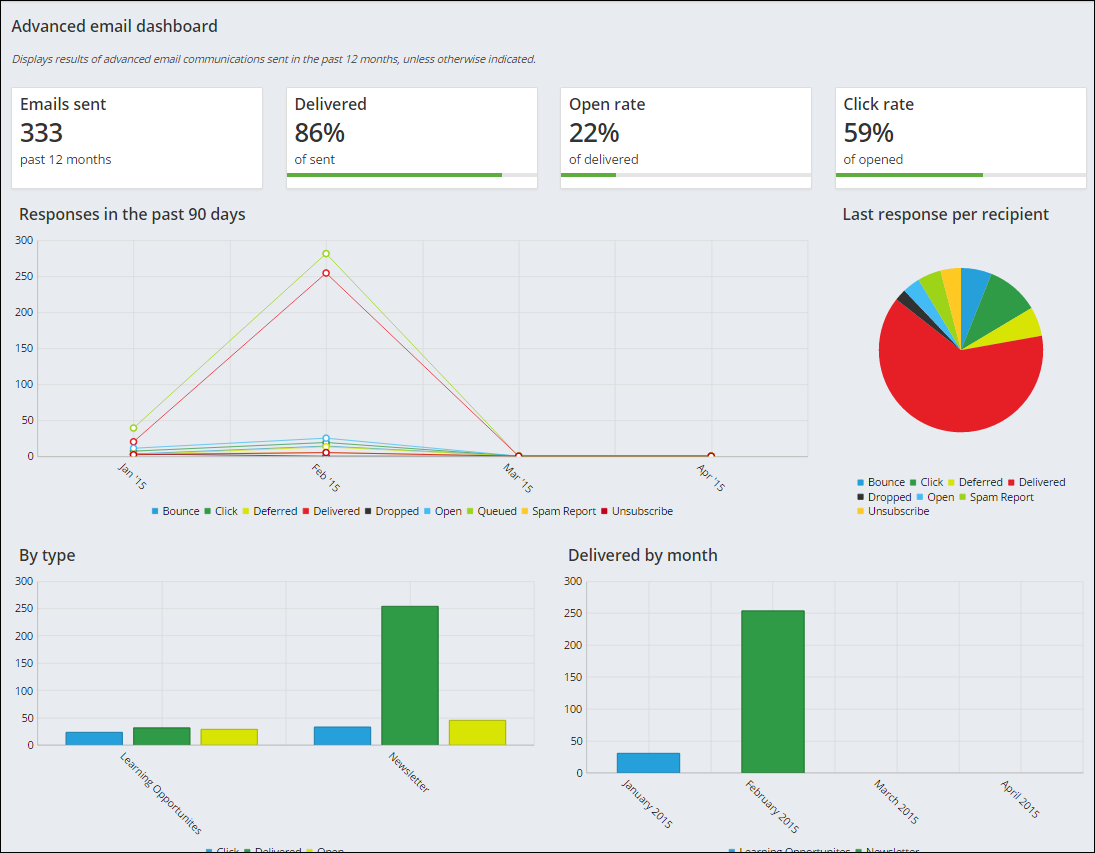
- The Opens and Clicks include the sum of all opened or clicked totals for each individual Advanced email. For example, if one recipient opens an email and clicks 4 different links in that specific email, the total number of Opens would be 1 and the total number of Clicks would be 4.
- The Open Rate and Click Rate indicate rates based on unique opens and clicks, thus multiple opens or clicks of the same email are totaled only once. The Open Rate reflects the number of recipients who have opened the email at least once, divided by the total number of emails that were successfully delivered. The Click Rate reflects the number of recipients who have clicked on any of the links within an email, divided by the number of emails that were opened.
When the communication subject is selected, the individual communication dashboard is displayed. The information on the individual dashboard is similar to the main dashboard. Some additional features include:
- The Sent chart reports all of the bounced, delivered, unsubscribed, and deferred emails. Unique deferred emails reflect only the single instance that the email was marked as deferred. See Troubleshooting for more information.
- Links clicked reports both the total clicks and unique clicks of each link that is contained in the Advanced email.
- Delivery Failures reports all of the bounced, marked-as-spam, deferred, and dropped emails. The reason for each failure as reported by the receiving end is listed with the recipient name and email address.
